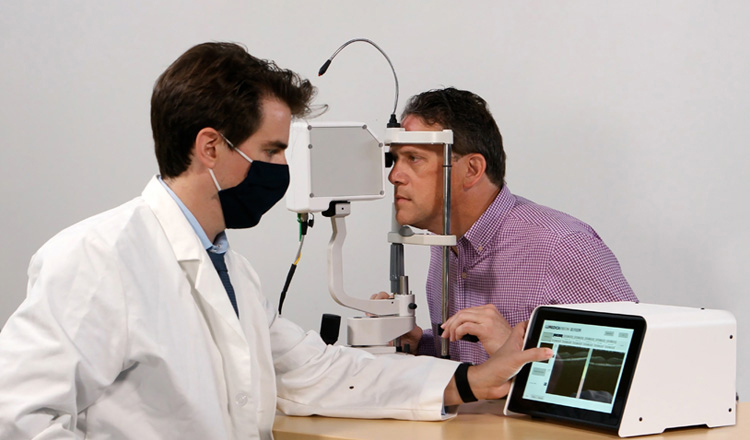 Lumedica—whose OQ EyeScope device is currently undergoing human clinical trials—is one of three biophotonics companies profiled here. [Lumedica Vision]
Lumedica—whose OQ EyeScope device is currently undergoing human clinical trials—is one of three biophotonics companies profiled here. [Lumedica Vision]
 Adam Wax, Lumedica co-founder [Courtesy of A. Wax]
Adam Wax, Lumedica co-founder [Courtesy of A. Wax]
Lumedica
A US-based OCT developer is disrupting the field with affordable devices.
Nearly a decade ago, Optica Fellow Adam Wax and William Brown, both veteran entrepreneurs, teamed up to realize a simple vision: making optical coherence tomography (OCT), a staple of the ophthalmologist’s office, much more affordable. The result was Lumedica, a startup the pair founded in 2014. Based in Durham, NC, Lumedica develops and markets inexpensive, shoebox-sized OCT devices.
“I’ve always been interested in commercialization, because, as a biomedical engineer, to have a technology that has an impact, you have to deliver a product that doctors can use,” says Wax, a professor at Duke University, NC, USA, who serves as Lumedica’s president, with Brown in the role of CTO. And, to Wax, making OCT technologies more accessible looked like an opportunity to realize that interest.
The innovator’s dilemma
Wax and Brown realized that they could disrupt biophotonics by making an OCT device that’s way more affordable than the ones in the market, which can have price tags up to around US$100,000. They soon came up with a path toward an OCT system that would be 10 times cheaper. Lumedica operated in stealth mode for three years after its founding to maintain a competitive advantage. When the product debuted at a Photonics West booth in 2017, some onlookers wondered if it was a toy, perhaps because of its compact size and low price.
“It followed the path of the innovator’s dilemma,” says Wax. “First, they ignored you, then they laughed at you, and then they were over there buying it.”
Since then, Lumedica has sold its products worldwide, in countries on five different continents. But it has tapped many sources of help on its journey. One lay in funds from the Small Business Innovation Research (SBIR) programs of the US National Institutes of Health (NIH) and the National Science Foundation (NSF). NSF’s SBIR program in particular—which calls itself “America’s Seed Fund”—awards more than US$200 million each year to about 400 startups across the United States, according to its website.
Wax says a phase-one SBIR grant is only “a modest amount of money,” at a couple hundred thousand US dollars or less—enough to demonstrate an idea’s feasibility. “You can move a company along with those. But … it’s not enough to really keep things funded.” After demonstrating viability in phase one, however, a company can qualify for a phase-two grant, which can be substantial, at US$1–$2 million. “That’ll really fund your product development from feasible idea to something perhaps that you can sell on the market,” Wax says.
In another coup, in 2019, Lumedica Vision, a part of Lumedica, was selected as one of 10 participants in the six-month business development “boot camp” of the Luminate Accelerator, based in Rochester, NY, USA. Wax enjoyed the experience because it not only gave the company money and publicity but also resulted in a lot of valuable (and free) feedback and presentation experience that helped him hone the company’s pitch. “It’s kind of the way that we, as professors, give talks and teach classes,” says Wax. “After some experience, you learn, ‘Oh, this joke always lightens the mood,’ or ‘This comparison really makes light bulbs light up in people’s brains.’”
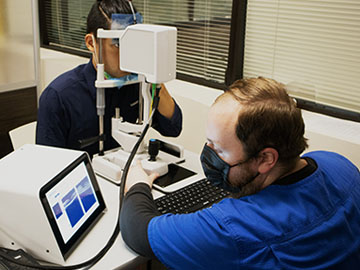 A demonstration using Lumedica Vision’s OQ EyeScope, which is yet to be approved by the FDA for clinical use. [Lumedica Vision]
A demonstration using Lumedica Vision’s OQ EyeScope, which is yet to be approved by the FDA for clinical use. [Lumedica Vision]
Another advantage Luminate offered was tapping into the “optics ecosystem,” according to Wax. Luminate is specifically designed for optics, photonics and imaging startups, so, he says, its staff knew about optics and offered access to a lot of relevant resources. And it was beneficial, he adds, to be surrounded by other startups that faced similar challenges in designing and manufacturing optical products.
Regulatory hurdles
One other challenge the startup had to navigate is the Current Good Manufacturing Practice (CGMP) regulations of the US Food and Drug Administration (FDA). “I would say the biggest burden on a startup company is getting the quality system in place,” Wax says, to certify all the vendors and to produce products under CGMP. As of this writing, Lumedica is still in the middle of its 50-patient clinical trial for human use of its retinal imaging system.
Though there is a lot of paperwork involved—Lumedica had to produce “literally thousands of pieces of paper describing our process, work instructions”—Wax values the rigor of the FDA process. By ensuring that companies are producing the highest quality products that are also safe to use, the clearance process “makes the United States the leading authority on the medical devices,” Wax says.
FDA approval will also help Lumedica reach markets outside the United States. According to Wax, some countries will accept FDA approval, accompanied by a bit of their own paperwork, in lieu of the country’s own regulatory process. That said, the regulations on medical devices vary widely country by country; some nations take their own regulations very seriously, while others allow a product to operate in the country as long as it was assembled on their soil, in which case Lumedica sends components to customers for assembly.
While waiting for FDA approval for use on human eyes, Lumedica has been focusing on animal research market, which lacks the regulatory scrutiny of human testing. Operating under the CE mark from European Union ensuring safety, Lumedica’s devices have been used in rodent tests of human drugs and in horses and pigs to test veterinary drugs. There’s a companion-animal market, too, for people who want to scan their pets to detect any sign of illness. “Animal systems sales for animal research account for a significant portion of our sales at this point,” Wax says.
“We’re staying true to what we think the market needs and what will be a successful product.” —Adam Wax, Lumedica
True to the vision
Lumedica has already started work to expand its market to other medical areas such as dermatology and gastroenterology. Though COVID-19 initially dampened marketing efforts, the company is now back on track, attending trade shows and conferences in person.
Wax says that one thing that’s been his driving force with Lumedica is “staying true to our vision.” Delivering biomedical products is a more complicated path than general optics, and it’s easy to get swayed by the views of others—especially to get backing from venture capitalists. “But there’s a place in between for a more modest investment and quite a good return, without engaging in that type of show,” Wax says. “Instead of trying to shape our company and our product into what we might think would be VC-backable, we’re staying true to what we think the market needs and what will be a successful product.”
 Bernard Gilly, GenSight co-founder [GenSight Biologics]
Bernard Gilly, GenSight co-founder [GenSight Biologics]
GenSight Biologics
A French firm is combining optogenetics and optoelectronic goggles for vision repair.
A blind man made headlines in 2021 when he reportedly partly regained his sight. A participant in a larger clinical trial, the patient—blind for more than three decades due to the neurodegenerative eye disease retinitis pigmentosa (RP)—had been injected with viruses carrying genetic instructions for a light-sensing protein, to be expressed in his retina. With the aid of special light-emitting goggles, he was able to identify objects by sight, which he couldn’t do before (optica.org/news/sight-optogen).
Behind this milestone—reported last year as a preliminary finding in Nature Medicine—was the French biotech company GenSight Biologics. When first formed in 2012, the company’s target was neurodegenerative diseases in general, according to co-founder Bernard Gilly. But, he notes, “the retina is, so to speak, the visible part of the brain … if I’m looking into your eyes closely enough, [even] without an instrument, I can see your retina, and thus I can see your brain.” So the company’s focus sharpened to diseases of the eye.
Two-pronged approach
At the center of the blind patient’s vision loss and partial restoration are the eye’s photoreceptors—which Gilly calls the CMOS sensors of human body. RP destroys sight by progressively killing these light-sensitive cells. But, the GenSight team asked, what if the cells’ function could be transferred to other retinal neurons? This simple yet sci-fi-sounding idea led the company into developing a two-pronged approach combining optogenetics with a medical device.
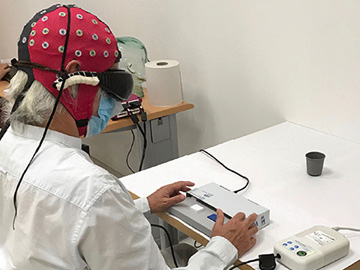 A blind man with RP participating in the PIONEER trial. [Reprinted with permission: J.-A. Sahel et al., Nat. Med. 27, 1223 (2021)]
A blind man with RP participating in the PIONEER trial. [Reprinted with permission: J.-A. Sahel et al., Nat. Med. 27, 1223 (2021)]
For the optogenetics part, the team chose a protein, ChrimsonR, that’s sensitive to 590-nm light, a safe wavelength for the retina—and that reacts to such light with a 10-to-15-ms response time, comparable to the brain’s image-processing time window. Leveraging gene-therapy techniques, the researchers would then inject a patient’s eye with viral vectors that would deliver ChrimsonR genes to the retina and embed them into the retinal ganglion cells. The implanted genes turned those cells into pseudo-photoreceptors sensitive to light at 590 nm.
The second part of the process uses a pair of goggles equipped with an event camera—a device that captures not a whole image, but pixel-to-pixel differences of the surroundings as the scene changes. That decreases not only the response time but the amount of data that the device needs to process. The goggles project the differences onto the retinal ganglion cells as a 590-nm, amber monochrome image, activating the pseudo-photoreceptors—which bypass the dead photoreceptors and transmit the signal directly to the brain’s visual cortex.
From animal to human trials
The initial preclinical trials, with animal models of RP, were “kind of tough,” according to Gilly. When the researchers tested the ChrimsonR system on rodents, for example, the animals exhibited light-associated behaviors. But because rodents are typically nocturnal, Gilly says, their behaviors couldn’t be linked to visual acuity. With nonhuman primates, since there was no established models for the disease, the company had to develop one (with the help of Institut de la Vision, Paris, France)—while not permanently blinding the monkeys, which would have been unethical. (The researchers created the model by chemically treating the monkeys to temporarily disable their photoreceptors, which later recovered.)
That primate trial proved successful, and the team moved on to one with human patients—the PIONEER study. After a closely monitored study to determine dose and response, the PIONEER phase I/II trial, involving completely blind patients (including the one who regained partial vision), got under way. The study is still ongoing; Gilly says, the company expects it to move into phase III—sometimes called the pivotal trial—at the end of 2023. From there, after recruiting patients, it will take about 18 months for the phase, and the clinical study, to be over.
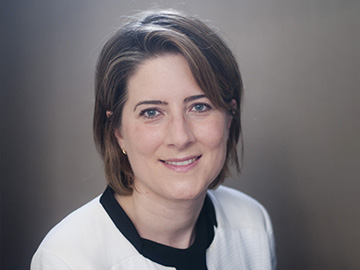 Marion Ghibaudo, Gensight CTO [GenSight Biologics]
Marion Ghibaudo, Gensight CTO [GenSight Biologics]
Parallel approach
GenSight has registered the PIONEER study in both the United States and Europe. But while one might hope for similar standards on the both sides of the Atlantic, that’s not always the case, according to Marion Ghibaudo, GenSight’s chief technical officer and the one overseeing development of the goggles.
And such jurisdictional differences, she continues, need to be considered from the very beginning. Even when picking out something as simple as an electronic component, a company must select the one that complies with the most recent standards of both the US Food and Drug Administration and the European Medical Device Regulation. “You won’t [be able to] change the component at the end of your development; it’s too late,” Ghibaudo says.
Such considerations also extend to the non-device side of the project, Gilly adds. In the clinical trials, the way the two agencies define trial outcomes could be different, for example. Fortunately, he says, both the US and European agencies now have special tracks for products like GenSight’s with both biological and medical-device components. That, he believes, makes getting through the process with such a product much easier now than it was five or ten years ago.
Toward a marketable system
While COVID-19 has slowed down the PIONEER phase I/II trials, progress continues, according to GenSight. In parallel, the company is focusing on improving the goggles. This requires experts in a variety of fields, ranging from optoelectronics to software development. Indeed, improving data-processing algorithms is particularly important, Gilly says, to quickly deliver visual information to patients’ brains.
On the device side, Ghibaudo says it will be important to widen the goggles’ currently limited, 10-degree field of view in time for the pivotal phase III study. At present, the lack of peripheral vision makes the device tiring for patients, she admits—and ensuring patient comfort is essential to keep them using the device.
“The goal for us is really to get to a point that [patients] will be able to recognize the faces of their relatives.” —Bernard Gilly, GenSight
Despite some flashy headlines, Gilly says GenSight remains very much an R&D company. As of this writing, it has a modest number of employees—45—mostly dedicated to its scientific operations. But the company is certainly growing, Gilly says—and is adding sales and marketing staff to support another gene therapy candidate the company is working on for a different disease.
“The goal for us is really to get to a point that [patients] will be able to recognize the faces of their relatives,” Gilly says of patients. He says it is too soon to discuss enabling the capability to read, which is “a more complex goal,” he says. “But I’m convinced that with time, we will get to this.”
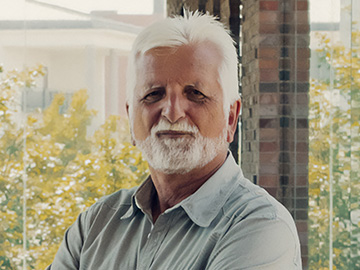 Werner Mäntele, DiaMonTech co-founder [DiaMonTech]
Werner Mäntele, DiaMonTech co-founder [DiaMonTech]
DiaMonTech
A German startup is developing a small, noninvasive glucose-monitoring device.
When asked to trace the origins of the glucose-monitoring technology at the heart of the German biotech startup DiaMonTech, the man behind the technology, Werner Mäntele, brings up an unlikely place: a brewery. Back in 2001—when he was mainly an academic scientist, and not yet DiaMonTech’s chief science officer—he got a chance to expand his infrared spectroscopy system into the hopping world of German beer.
The prototype sensor that Mäntele built for the beer market, by his reckoning, could determine a brew’s ingredients in less than a minute with extreme sensitivity and precision. Sadly, however, using infrared spectroscopy to detect the ingredients of beer didn’t catch on, as the technology of the day made the system too expensive and too bulky to be practical in breweries.
Technology has significantly advanced in the two decades since, however, and Mäntele is now taking the idea from beer to biomedicine. In 2014, Thorsten Lubinski, an experienced entrepreneur, approached him and suggested founding a startup. Mäntele—who believes that entrepreneurship isn’t strongly encouraged at German universities—says that, being “a good German professor,” he didn’t know much about startups. But, he took a leap of faith and co-founded DiaMonTech with Lubinski (now its CEO) and two other partners.
Photothermal deflection technology
Constant glucose monitoring can be painful experience for many people with diabetes and pre-diabetes, involving pricking one’s finger to draw blood. To make the patients’ lives easier, numerous companies have looked to bring noninvasive testing approaches to market, focusing on tapping into other bodily fluids such as sweat and teardrops. Often, however, these fluids fail to reflect one’s blood glucose level in a sufficiently timely manner, according to Mäntele.
But scientists at DiaMonTech—whose name is a portmanteau of “diabetes monitoring technology”—found the answer in interstitial fluid, the bodily fluid found in the spaces around cells. The glucose levels of the fluid and the blood equilibrate within minutes, leading to only a minimal lag time. And the fluid is abundant in the body, creating avenues for easy measurement.
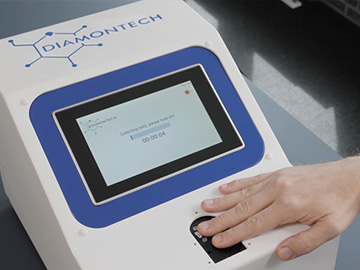 A demonstration of D-Base, a shoebox-sized glucose-monitoring device, which is not for sale. But a prototype of a smaller device, D-Pocket, will be available at the end of this year, Mäntele predicts. [DiaMonTech]
A demonstration of D-Base, a shoebox-sized glucose-monitoring device, which is not for sale. But a prototype of a smaller device, D-Pocket, will be available at the end of this year, Mäntele predicts. [DiaMonTech]
The DiaMonTech device accesses the fluid—and its glucose level—underneath one’s skin using photothermal deflection spectroscopy. The chip-sized quantum cascade lasers (QCLs) in the device focus mid-IR beams of varying wavelengths on the skin, penetrating around 100 µm deep—enough to access the interstitial fluid (but not the blood vessels) without the need of a pinprick. The beams excite the vibrational modes of glucose molecules, and as they relax, the molecules emit small amount of heat, raising the temperature by a few millikelvins.
Then the device shoots a second laser beam from a simple red diode laser to measure the glucose level. The heat—and the resulting heat gradient—changes the refractive index of the sensor crystal, which can be read in the deflection of the red beam. The deflection amplitude can be tied to the concentration of glucose in the interstitial fluid and in the blood.
QCL revolution
Using this technology, DiaMonTech developed a device called D-Base, which is a shoebox-sized glucose-monitoring device that subsequently received its CE mark. But that’s not where DiaMonTech’s end goal lies, says Mäntele. The company is working toward a device that’s truly portable—a smartphone-sized device named D-Pocket.
Previously, it wasn’t possible to so radically miniaturize a mid-IR spectrometer. Earlier generations of lasers in that spectral band, such as CO2 lasers, were bulky, offered limited numbers of wavelength, and in some cases could operate only cryogenically—all of which made them unsuitable for the practical applications the company was aiming for.
“And then around turn of the century, the quantum cascade laser came out; and wow,” Mäntele exclaims. The key component in DiaMonTech’s devices, QCLs could easily emit pulsed or CW beams in the tens of milliwatts—and, a bit later, became tunable with the addition of an external cavity. QCLs have now improved still further, being available on fingernail-sized chips. An array of 15 such QCL chips, each at a different wavelength, is what will enable the D-Pocket blood glucose analyzer, Mäntele says.
Mäntele predicts that the D-Pocket prototype will be available by the end of this year. In the meantime, the company is continuing to use D-Base for various tests, including a US Food and Drug Administration (FDA) clinical trial. Once D-Base is FDA approved, Mäntele maintains, it will be easy to get D-Pocket approved, as both devices are based on the same principle.
Wearable glucose monitoring?
Because the company is focusing its effort on the portable-device market, the shoebox-sized D-Base is currently not for sale. To sustain itself during the process of D-Pocket development and regulatory approval, DiaMonTech is has relied in part on several funding rounds.
In the most recent of these, a consortium of four investment groups, including Samsung Ventures, the US-based venture-capital firm Unorthodox Ventures, Germany’s Golden Light, and a global medtech company, made a US$5 million strategic investment in the company. The investment—which reportedly brings DiaMonTech’s total external funding to more than US$20 million—is intended, according to a press release, to “accelerate DiaMonTech’s product development and enable its international expansion to the US.” The company also enjoys a small revenue stream from providing IR spectroscopy to other companies to help them monitor fermentation processes. “DiaMonTech is not a one-trick pony,” Mäntele says.
“I want to sit on the marketplace in Italy, and then see someone pulling out D-Pocket before he takes a piece of cake.” —Werner Mäntele, DiaMonTech
The company is even looking into making a wearable version of its testing device. Here, again, fingernail-sized QCL chips will become essential, though integrating a sensor into a watch-sized device could prove a challenge.
It’s a challenge that motivates Mäntele, however—especially when he hears from people with diabetes. “We have had diabetes patients that [have] pricked [their fingers] 150,000 times in their life,” Mäntele says. “That’s no fun,” especially for children with diabetes and their parents.
For all these patients, he wants to see DiaMonTech product in the market—and eventually in their lives. “I want to sit on the marketplace in Italy, to drink my cappuccino, and then see someone pulling out D-Pocket before he takes a piece of cake,” Mäntele says.
Karen Kwon is OPN’s associate editor.
